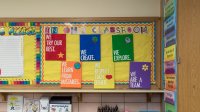How to Create Classroom Agreements Using Poetry
Teachers can use students’ input and artistic expression to generate class norms that support a positive, respectful learning environment.
Your content has been saved!
Go to My Saved Content.It’s the start of the school year, and it’s good practice to establish some kind of class agreement that explicitly but positively connects classroom expectations to school rules and values. It’s even better practice to establish class expectations with the students’ ideas, perspectives, and contributions. After all, it’s their learning space. Over the years, I’ve done this in different ways, but for me, being a poet myself, the most successful and most interdisciplinary way has been to use poetry.
Class agreements often involve learning traits and school values that we associate with being learners and also include adults. I ask the students what they feel are the key traits for learning and how they want them demonstrated in the classroom—our shared space. This generates a list of nouns that overlap with school values. Words like caring, kindness, respect, responsibility, etc., are fairly universal. They are the ingredients that we all understand.
Metaphors Can Help Students Explore How to Be a Learner
The list lends itself to a nonfiction instructional text poetry form whereby we think of how to make/bake/cook/create a learner. Using a cake or cookie as the overall metaphor usually makes everyone’s eyes sparkle.
For this, I take the following steps (which I have used with all age groups in elementary schools), adapting language expectations accordingly:
1. Brainstorm active verbs associated with cooking. This is a great early language formative assessment.
2. Review how you make a real cake and the sequence of actions. When do you roll? When do you sprinkle? What do you cut, mix, mash, etc.? This is a great place to review sequential adverbs like first, secondly, next, afterward, etc.
3. Add metaphors for older students. The bowl could be the bowl of good intentions. The oven becomes the oven of perseverance.
4. When drafting the poem, you can have students produce their own, which is excellent for an early formative assessment of writing skills. They can also work in pairs or groups, which helps you assess their collaboration and social skills. Or, if pressed for time, you can use a shared writing model and create one as a whole class. Shared writing is a British phrase for something you probably already occasionally do: modeling how to write a text using your students’ ideas and suggestions, thinking out loud as you write, and pretending to get stuck on grammar and spelling so that the students can fix the problems.
5. For an extra “topping,” you can add actions and have students recite the poem in an assembly to the school community.
Try Other Forms of Poetry to Highlight School Values
A common poetry form rolled out when a school requests a focus on values is the acrostic poem. This is where you write the word down the left-hand side of the page and then start each line using a letter of that word. Acrostic poems can be easier for younger students and take less time, but they can also be expanded and are an opportunity for students to be creative.
Follow these three tips to get more out of an acrostic poem:
1. Have students draft ideas around the school value before writing the acrostic.
2. Use all the senses. What does “respect” (for example) look, sound, feel, taste like?
3. Require that each line of the acrostic be an actual fully fleshed-out line, not just a single word or phrase. This will help the poem combine poetic depth with clever artifice.
Here’s an example:
Respect is a glowing light that inspires hearts and minds to shine.
Everyone deserves respect, no matter their age or culture, their gender or job.
Showing respect can be done by listening, asking questions, and making time.
People deserve respect as much as they need food, air, shelter, and love.
Eat with good manners to show respect for those who make us lunch.
Create a world where you give as much respect as you take.
Try to see those who are not visible, and listen to those who cannot speak.
I personally prefer free-verse poetry, which contains all the same emphasis on language but without any rules around rhyming or structure. Free verse works especially well for this kind of work on classroom values. You can have students create a poem that answers the question, “What is respect?” The answer is the poem, “Respect Is….” You can use all the ideas generated above and refer to the senses and provide concrete examples.
Doing this might result in a list poem format, which is also a valid form. Alternatively, you can have students focus on a few favorite examples that are described in individual stanzas. Either way, these forms of poetry serve as excellent formative assessments of all the components of writing, from figurative language to spelling and handwriting.
With any of the poetic forms, I conclude by having the students share their poems. This helps me reinforce, very early on, the expectations around listening, encouraging feedback, and celebrating creativity. I find that most students are keen to share. The few that aren’t will do with encouragement, but they also inadvertently help teach me about their confidence, language competency, or past experiences. After all, we are all learners and we can all be poets.
